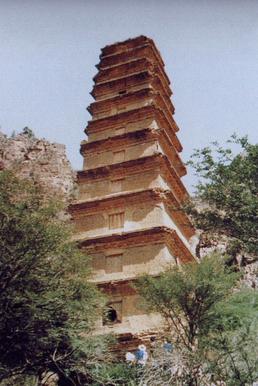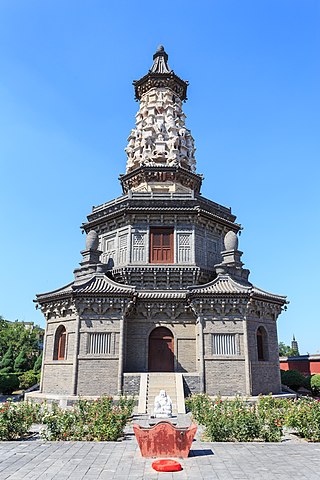
Ningxia, officially the Ningxia Hui Autonomous Region, is an autonomous region in the northwest of the People's Republic of China. Formerly a province, Ningxia was incorporated into Gansu in 1954 but was later separated from Gansu in 1958 and reconstituted as an autonomous region for the Hui people, one of the 56 officially recognised nationalities of China. Twenty percent of China's Hui population lives in Ningxia.

Yinchuan is the capital of the Ningxia Hui Autonomous Region, China, and was the capital of the Tangut-led Western Xia dynasty. It has an area of 8,874.61 km2 (3,426.51 sq mi) and a total population of 2,859,074 according to the 2020 Chinese census, and its built-up area was home to 2,564,918 inhabitants spread between three urban districts and Helan and Yongning counties largely being urbanized. The city's name literally means "silver river".

The Helan Mountains, frequently called Alashan Mountains in older sources, are an isolated desert mountain range forming the border of Inner Mongolia's Alxa League and Ningxia. They run north-south parallel to the north-flowing Yellow River in the Ordos Loop section. The river is mostly east of the mountains, but in the north it crosses without making a significant gorge and flows on the west side. To the west lies the extremely arid Tengger Desert, while to the east is an irrigated area beside the Yellow River, in which lie the cities of Yinchuan and Shizuishan - a little further east of which lies the Mu Us portion of the Ordos Desert. To the north lies the Inner Mongolian city of Wuhai.

Xixia District is one of three urban districts of the prefecture-level city of Yinchuan, the capital of Ningxia Hui Autonomous Region, Northwest China, bordering Inner Mongolia to the west. It has a total area of 987 km2 (381 sq mi), and a population of 200,000 people.

Helan County is a county of Ningxia Hui Autonomous Region, China, it is under the administration of the prefecture-level city of Yinchuan, the capital of Ningxia, and borders Inner Mongolia to the northwest. It has a total area of 1,600 km2 (620 sq mi), and a population of approximately 180,000 people.

Baisigou Square Pagoda was a brick pagoda in Helan County, Ningxia, China, built during the early years of the Western Xia dynasty (1038–1227), circa 1075–1076. It is situated in an isolated location about 10 km into the Baisigou Valley on the eastern side of the Helan Mountains, northwest of Yinchuan, but may have been the site of an important Buddhist temple during the Western Xia. The pagoda was illegally destroyed in 1990; archaeological investigation of the ruins has uncovered a large number of Tangut artefacts and Buddhist relics, including books and manuscripts written in the Tangut language and script.

The Auspicious Tantra of All-Reaching Union is the title of a set of nine volumes of Buddhist printed texts written in the Tangut language and script which was discovered in the ruins of the Baisigou Square Pagoda in Helan County, Ningxia, Northwest China in 1991 after it had been illegally blown up.

Yinchuan Helanshan Football Club was an association football club based in Yinchuan, Ningxia, China. The Helan Mountain Stadium was their home venue.

The Pagoda of Chengtian Temple, meaning 'Bearing Heaven Pagoda', is an eleven-storeyed brick pagoda located on the site of a previous Buddhist temple in Yinchuan city, Ningxia, China. The pagoda was originally built during the Western Xia, but the current structure dates to the Qing dynasty. At 64.5 metres (212 ft) in height it is the tallest pagoda in Ningxia. In contrast to the Haibao Pagoda in Yinchuan, which is known as the Northern Pagoda, Chengtian Temple Pagoda is also informally referred to as the Western Pagoda.

The Hongfo Pagoda, meaning 'Grand Buddha Pagoda', is an octagonal brick pagoda located in Helan County, just north of Yinchuan city, in Ningxia, China. The pagoda was built during the Western Xia (1038–1227), and when it was renovated in 1990 a number of Western Xia statues and printed texts were discovered.

Hongsibu District is a district within the prefecture-level city of Wuzhong in the autonomous region of Ningxia, China.

The Haibao Pagoda Temple is a Buddhist temple located in Xingqing District of Yinchuan, Ningxia, China. Because of earthquakes, the modern temple was founded in the 18th century in the period of the Qianlong Emperor (1736–1796) during the mid-Qing dynasty (1644–1911). It is the headquarters of the Buddhist Association of Ningxia.
Guangjiao Temple is a Buddhist temple located in Xuanzhou District, Xuancheng, Anhui, China. Alongside Huacheng Temple, Cuifeng Temple and Kaihua Temple, it is honoured as the "Four Famous Buddhist Temples in Anhui". It was first built in the Tang dynasty by a prominent Chan master Huangbo Xiyun, and went through many changes and repairs through the following dynasties. Most of the present structures in the temple were repaired or rebuilt between 2004 and 2006.

Yinchuan–Xi'an high-speed railway, is a dual-track, electrified, high-speed rail line in Northwest China between Yinchuan and Xi'an. The line is the first railway to connect Qingyang to the Chinese railway network, and also the first railway to connect Ningxia and Yinchuan to the high-speed railway network.
Lady Mozang, posthumous name Empress Xuanmu Huiwen, was a consort of Emperor Jingzong of Western Xia. She was regent of Western Xia during the minority of her son Emperor Yizong of Western Xia in 1048 from 1056.

Yinchuan Xihuayuan Airport was the former main airport of Yinchuan, Ningxia, China. It was built on orders of Ningxia governor Ma Hongkui in 1935 as a military airport with a gravel runway. The airport was closed from September 1949 to September 1958. In 1958, the airport was renovated to welcome the establishment of the Ningxia Hui Autonomous Region, of which Yinchuan became the capital. After the renovation, the Xihuayuan Airport had a gravel runway with a length of 1415 meters and a width of 40 meters. On 20 October 1958, a CAAC Il-14 passenger plane landed at the airport, marking the official resumption of flights at the airport.
Mozang Epang was an ethnic Tangut statesman and chancellor of the Western Xia dynasty of China during the reign of the Emperor Jingzong and Emperor Yizong.
Ningling Ge was a crown prince of the Western Xia dynasty and the fourth son of the Emperor Jingzong, the founding monarch. Ningling Ge was a member of Tangut Weiming (嵬名) clan.

Guanghui Temple Huata,, is located on Guanghui Road, Zhengding County, Shijiazhuang City, Hebei Province, People's Republic of China, and is a 4-story octagonal Huata. The tower was built in the Tang Dynasty and rebuilt in the Dading years of the Jin Dynasty. The entire pagoda has 3 floors in the style of an attic, with steps on the first and second floors, and 2 statues of Buddha enshrined in the heart chamber of the pagoda on the third floor. The fourth layer is a bouquet-shaped pagoda statue of warriors, elephants, lions and Bodhisattvas. During the Republic of China period, the four sets of chambers below the tower were destroyed during the war. In 1961, Guanghui Temple Huata was listed as a national key cultural relic protected unit. In 1999, the repair project of Guanghui Temple Huata was completed, and the whole temple was restored to its original appearance.

















